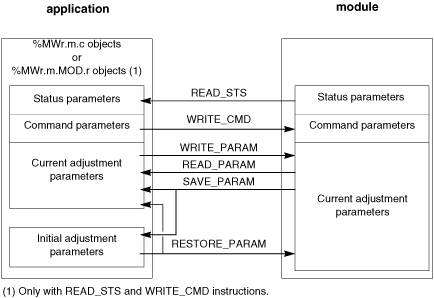Explicit exchanges are performed at the user program's request using these instructions:
-
READ_STS (read status words)
-
WRITE_CMD (write command words)
-
WRITE_PARAM (write adjustment parameters)
-
READ_PARAM (read adjustment parameters)
-
SAVE_PARAM (save adjustment parameters)
-
RESTORE_PARAM (restore adjustment parameters)
These exchanges apply to a set of %MW objects of the same type (status, commands or parameters) that belong to a channel.
These objects can:
-
provide information about the module (for example, type of error detected in a channel)
-
have command control of the module (for example, switch command)
-
define the module’s operating modes (save and restore adjustment parameters in the process of application)
NOTE: To avoid several simultaneous explicit exchanges for the same channel, it is necessary to test the value of the word EXCH_STS (%MWr.m.c.0) of the IODDT associated to the channel before calling any EF addressing this channel.
NOTE: Explicit exchanges are not supported when X80 analog and digital I/O modules are configured through an eX80 adapter module (BMECRA31210) in a Quantum EIO configuration. You cannot set up a module's parameters from the PLC application during operation.
General Principle for Using Explicit Instructions
The diagram below shows the different types of explicit exchanges that can be made between the application and module.
During an explicit exchange, check performance to see that the data is only taken into account when the exchange has been correctly executed.
To do this, two types of information is available:
The following diagram describes the management principle for an exchange.
NOTE: In order to avoid several simultaneous explicit exchanges for the same channel, it is necessary to test the value of the word EXCH_STS (%MWr.m.c.0) of the IODDT associated to the channel before calling any EF addressing this channel.

